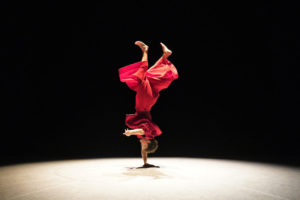
San Francisco Opera 2022-23 Review: Orpheus and Eurydice
Jakub Józef Orlínski Does it All in Brilliant Interpretation of Gluck’s Masterpiece
By Lois SilversteinSan Francisco Opera outdid itself with Christoph Willibald Gluck’s 18th century masterpiece, “Orpheo ed Euridice.” An absolute gem, the opera was the piece de resistance of the season.
The cast, the set, the music, all in a new production by director Matthew Ozawa and conducted by acclaimed early music interpreter Peter Whelan in his American opera stage debut. Rena Butler made her San Francisco choreography debut, preparing dances which are integral to the production. San Francisco’s Company Chorus
Director John Keene led the artists of the San Francisco Chorus. Ozawa worked with set designer Alexander V. Nichols and costume designer Jessica Jahn on the set and projections. They also collaborated with Yuki Nakase Link on the lighting design. All these different parts artfully created a beauteous whole.
Doing it All
The brilliant Polish countertenor, Jakub Józef Orlínski, was almost more than superlative. From the moment he tumbled on stage in red sateen, and joined a group of dancers in red and blue—yes, he is a break dancer as well!—we were captivated. It was easy to become mesmerized by the performance: there were no intermissions for nearly 90 minutes.
His voice is creamy, dynamic, resonant, and with remarkable range. It was hard not to try to hang on every note, each so rich and beautiful in its own right. In addition to this, he sang the whole work with great immediacy. We felt his grief and his disorientation through every stage of its evolution. Hearing and witnessing it, we remained entirely under his spell.
The fact that Orlínski, making his San Francisco debut, danced as well as sang throughout made for a tour de force. Was he not literally a grieving lover lost in a wilderness without his beloved? He was a dancer, a tumbler, an acrobat. What he started with his voice he continued in his body, shifting, falling, flying, climbing, pirouetting, waltzing with his darling Eurydice lying dead in a flowered bier, and barely able to tolerate it for a single moment more. We recognize this story as well: it is our own, our own loves, our own losses and regrets, when we become torn apart by our own conflicting demands.
The beautiful Eurydice, sung by Chinese soprano Meigui Zhang’s, veiled and brought from the underworld at Orpheus’ request, was also wrapped up in her own wants and needs. During the second act, Zhang’s voice was plangent and full of pathos as she pleaded with Orpheus to do one simple thing – look at her.
Love personified appeared, sung in luminous voice by soprano Nicole Heaston, descending on a swing when summoned by Jove, who had taken pity on Orpheus. Adorned in a satin orange-yellow outfit, barefoot and buoyant, saucy, almost silly, Heaston’s appearance as Love and her lyrical, quasi-comedic, style shifted the tone and the mood.
Par Excellence
The dancers, choreographed by Butler—herself a dancer and choreographer par excellence—performed dynamically, athletically, and perfectly. Costumed in muted blue and red, they complemented what was going on within the dialogue and the music, rather than simply illustrating or amplifying it. The bowing and bending, the emphasis on sinuous movement, all reinforced the surging grief and reminded us time and again how it flows and floats, pulling our whole being down and then up again in waves. They did much to create, with their gestures, a whole universe of sorrow and loss. It is not Orpheus’ or Eurydice’s sorrow alone which we see on stage, but that of the whole universe. This is a big story, and one we all have to deal with to in order to remain a part of existence. We have to create and retain a sense of integration, or else we will remain continuously buffeted by loss and grief.
The mourners in Act One, all from the San Francisco Opera Chorus, came as a procession surrounding Orpheus and did not exaggerate in their role, limping pitifully around moaning and groaning: instead they visually and melodically established the emotional scene in which Orpheus had to exist. They appeared in white and just as quickly disappeared, singing as if in pantomime. This provided an additional dimension to Orpheus, his pleading, and his Promethean endeavour to pull the two lovers back together again.
The music was clarion, the pace presto and langoroso where it needed to be, and highly expressive and moving throughout. Whelan balanced the music and the voices of the dancers with dramatic intensity and clear, pearl-like luminosity. This union of movement and sound enabled us to hear and feel all the stages of grief which Orpheus was forced to experience.
The audience left the performance with a sense of unity, a sense of being in equilibrium with all parts of the universe. All in all, it was a wondrous performance.


